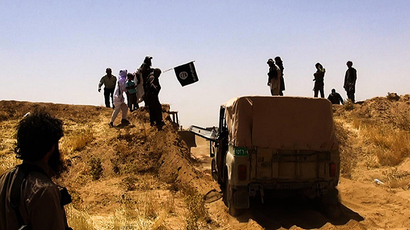‘Abandoned’ barrels containing deadly sarin seized in rebel-held Syria

UN Secretary General Ban Ki-moon informed Security Council members on Monday that two cylinders reportedly seized by Syrian government forces in an opposition-held region appeared to contain the deadly nerve agent sarin.
According to the letter dispatched by Ban to the UNSC, on June 14 the Organisation for the Prohibition of Chemical Weapons (OPCW) analyzed the contents of the barrels, reported Reuters. The UN Joint Mission is currently overseeing the destruction of Syria’s chemical weapons stockpiles under the umbrella of the OPCW.
Syria has declared a total of 1,300 tons of chemical agents, and handed over the last portion of its stockpile on June 23 under the agreement reached in September.
"The Joint Mission confirmed that these contained sarin," read Ban's letter. The Syrian government declared the barrels “as abandoned chemical weapons,” which were reportedly seized by government forces in August 2013 within an area under the control of armed rebel groups.
OPCW chief Ahmet Uzumcu did not include in his report the precise date the Syrian government had handed over the two cylinders
On Monday the US container ship Cape Ray began to neutralize chemical weapons materials according to the Pentagon. Some 600 metric tons of materials, including components for mustard gas and sarin, were transferred earlier in July to the Cape Ray from a vessel that initially transported them from Syria.
The Syrian government agreed last year to dispose of its chemical weapons stockpile, part of a disarmament deal brokered between Assad, the US and Russia following allegations of the regime’s use of deadly agents against civilians. That crisis was triggered after evidence emerged of a potential sarin gas attack last August which killed hundreds of civilians on the periphery of the capital of Damascus.

While the US and European powers blamed the Assad government for the Damascus chemical weapons attack, the country’s government instead blamed rebel groups who are seeking its ouster. The disarmament agreement was seen as a compromise that prevented US airstrikes on Syria, which last summer had seemed mere hours away from being realized.
The Cape Ray will require at least 60 days to process the chemical weapons materials, using a hydrolysis process to neutralize warfare agents with substances such as water, sodium hydroxide and sodium hypochlorite. The resulting materials are then safe for disposal at commercial sites, and will likely be transferred to Finland and Germany.
The head of the UN’s joint disarmament mission, Sigrid Kaag, briefed the Security Council on Monday regarding the project’s progress. According to Ban’s letter on Monday the mission must still verify with the Syrian government “any possible remaining discrepancies in the original declaration” of its chemical weapons stockpile.
"It is now essential that every effort be made to achieve the full elimination of the chemical weapons program of the Syrian Arab Republic at the very earliest opportunity, including the destruction of remaining production facilities and the resolution of any possible remaining technical discrepancies in the original declaration," Ban wrote.
Now in its fourth year, the Syrian civil war has claimed over 150,000 deaths, and resulted in one of the largest modern refugee situations in modern history. An estimated 9 million Syrians have fled their homes since the outbreak of violence in March of 2011 according to EU estimates. Some 2.5 million fled to neighboring countries of Turkey, Lebanon, Jordan and Iraq.














